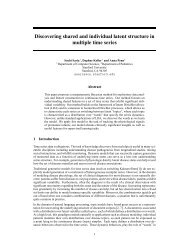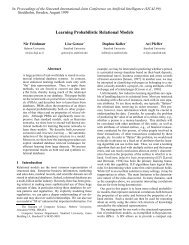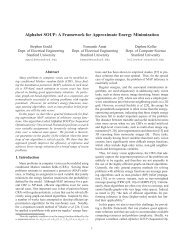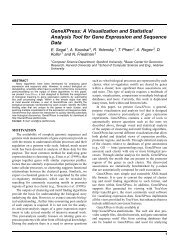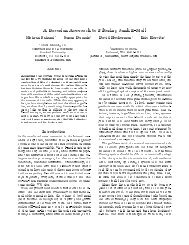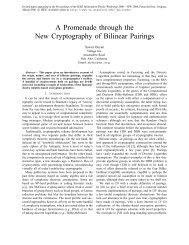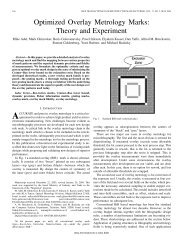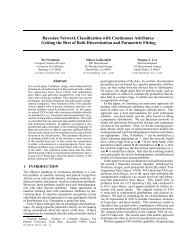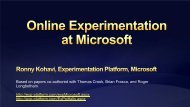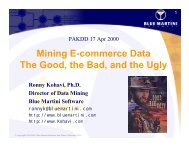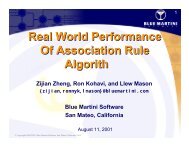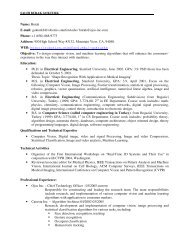Assembly for Metagenomes - Stanford AI Lab - Stanford University
Assembly for Metagenomes - Stanford AI Lab - Stanford University
Assembly for Metagenomes - Stanford AI Lab - Stanford University
Create successful ePaper yourself
Turn your PDF publications into a flip-book with our unique Google optimized e-Paper software.
Genovo: De Novo <strong>Assembly</strong> <strong>for</strong> <strong>Metagenomes</strong><br />
Jonathan Laserson, Vladimir Jojic, and Daphne Koller ⋆<br />
Department of Computer Science, Stan<strong>for</strong>d <strong>University</strong>, Stan<strong>for</strong>d CA 94305, USA<br />
koller@cs.stan<strong>for</strong>d.edu<br />
Abstract. Next-generation sequencing technologies produce a large<br />
number of noisy reads from the DNA in a sample. Metagenomics and<br />
population sequencing aim to recover the genomic sequences of the species<br />
in the sample, which could be of high diversity. Methods geared towards<br />
single sequence reconstruction are not sensitive enough when applied in<br />
this setting. We introduce a generative probabilistic model of read generation<br />
from environmental samples and present Genovo, a novel de novo<br />
sequence assembler that discovers likely sequence reconstructions under<br />
the model. A Chinese restaurant process prior accounts <strong>for</strong> the unknown<br />
number of genomes in the sample. Inference is made by applying a series<br />
of hill-climbing steps iteratively until convergence. We compare the per<strong>for</strong>mance<br />
of Genovo to three other short read assembly programs across<br />
one synthetic dataset and eight metagenomic datasets created using the<br />
454 plat<strong>for</strong>m, the largest of which has 311k reads. Genovo’s reconstructions<br />
cover more bases and recover more genes than the other methods,<br />
and yield a higher assembly score.<br />
1 Introduction<br />
Metagenomics and population sequencing aim to recover the genomic sequences<br />
in a genetically diverse environmental sample. Examples of such environments<br />
include biomes of narrow systems such as human gut [13], honey bees [8], or<br />
corals [23,19] and also larger ecosystems [24,22]. These studies advance our systemic<br />
understanding of biological processes and communities. In addition, the<br />
recovered sequences can enable the discovery of new species [24] or reveal details<br />
of poorly understood processes [26]. Another set of examples include cancer tumor<br />
cells [27] and pathogen populations such as HIV viral strains [25], where<br />
the genetic diversity is associated with disease progression and impacts the effectiveness<br />
of the drug treatment regime. Finally, the genetic structure of microbial<br />
populations may yield insight into evolutionary mechanisms such as horizontal<br />
gene transfer, and enable determination of genetic islands carrying functional<br />
toolkits necessary <strong>for</strong> survival and pathogenicity [20].<br />
Such studies are made possible through the use of next-generation sequencing<br />
technologies, such as the Illumina Genome Analyzer (GA), Roche/454 FLX<br />
system, and AB SOLiD system. Compared to older sequencing methods, these<br />
⋆<br />
JL and VJ contributed equally to this work. Correspondence should be addressed<br />
to DK.<br />
B. Berger (Ed.): RECOMB 2010, LNBI 6044, pp. 341–356, 2010.<br />
c○ Springer-Verlag Berlin Heidelberg 2010
342 J. Laserson, V. Jojic, and D. Koller<br />
sequencers produce a much larger number of relatively short and noisy reads of<br />
the DNA in a sample, at a significantly lower cost.<br />
While there are a few de novo assemblers aimed at single sequence reconstruction<br />
from short reads [6,29,15,5], there are no such tools designed specifically <strong>for</strong><br />
metagenomics. The challenges stem from uncertainty about the population’s size<br />
and composition. Additionally, coverage across species is uneven and affected by<br />
the species’ frequency in the sample. Analysis of the complete populations requires<br />
sensitive methods that can reconstruct sequences even <strong>for</strong> the low-coverage<br />
species. Methods geared towards single sequence reconstruction are not sensitive<br />
enough when applied in this setting.<br />
Such single sequence reconstruction tools commonly frame the problem as<br />
a search <strong>for</strong> an Eulerian path in a de Bruijn graph. The nodes of the graph<br />
are k-mers, with an edge connecting any two k-mers positioned consecutively<br />
on the same read. As mentioned by Chaisson et al. [7], “the Eulerian approach<br />
works best <strong>for</strong> error-free reads and quickly deteriorates as soon as the reads<br />
have even a small number of base-calling errors”. To cope with this problem, a<br />
large computational ef<strong>for</strong>t is used to detect and correct read errors be<strong>for</strong>e any<br />
assembly is done. While this approach is feasible <strong>for</strong> the ultra-short Illumina<br />
reads, the task becomes much harder in 454 reads, as the average read length is<br />
above 100 (and can reach 400b) and almost every read has an error. In addition,<br />
the error correction usually treats reads with low-frequency k-mers as erroneous<br />
and discards them. In metagenomics, this could filter out low-frequency species.<br />
We introduce a generative probabilistic model of read generation from environmental<br />
samples and present Genovo, a novel de novo sequence assembler that<br />
works by discovering likely sequence reconstructions under the model. The model<br />
captures the uncertainty about the population structure as well as the noise<br />
model of the sequencing technology. A Chinese restaurant process prior accounts<br />
<strong>for</strong> the unknown number of genomes in the sample. To discover likely assemblies<br />
we per<strong>for</strong>m a series of deterministic and stochastic hill-climbing moves, based<br />
on the iterated conditional modes (ICM) algorithm. As we show, our Bayesian<br />
approach offers a better sensitivity <strong>for</strong> assembly in highly diverse environments.<br />
The accurate and sensitive reconstruction of populations has been tackled<br />
in restricted domains, such as HIV sequencing, both experimentally [25] and<br />
computationally [16,11,28]. However, these tools require prior in<strong>for</strong>mation on the<br />
population and utilize a reference genome. A Chinese restaurant process, similar<br />
to ours, was also used in the recent work of Zagordi et al [28]. However, their<br />
approach is applicable only to a very small-scale (10 3 ) set of reads already aligned<br />
to a short reference sequence. Our method uses no prior in<strong>for</strong>mation, scales up to<br />
the order of 10 5 454 reads, and simultaneously per<strong>for</strong>ms read multiple alignment,<br />
read denoising and de novo sequence assembly.<br />
We compare the per<strong>for</strong>mance of our algorithm to three state of the art short<br />
read assembly programs in terms of the number of GenBank bases covered,<br />
the number of amino acids recognized by PFAM profiles, and using a score<br />
we developed, which quantifies the quality of a de novo assembly using no external<br />
in<strong>for</strong>mation. The comparison is conducted on 8 metagenomic datasets
Genovo: De Novo <strong>Assembly</strong> <strong>for</strong> <strong>Metagenomes</strong> 343<br />
[20,3,4,8,23,10] and one synthetic dataset. Genovo’s reconstructions show better<br />
per<strong>for</strong>mance across a variety of datasets. Genovo is publicly available online at<br />
http://cs.stan<strong>for</strong>d.edu/genovo.<br />
2 Methods<br />
Probabilistic Model<br />
An assembly consists of a list of contigs, and a mapping of each read to a<br />
contiguous area in a contig. The contigs are represented each as a list of DNA<br />
letters {bso}, wherebso is the letter at position o of contig s. For each read<br />
xi, we have its contig number si, and its starting location oi within the contig.<br />
We denote by yi the alignment (orientation, insertions and deletions) required to<br />
match xi base-<strong>for</strong>-base with the contig. Bold-face letters, such as b or s,represent<br />
the set of variables of that type. The subscript −i excludes the variable indexed<br />
i from the set.<br />
Our probabilistic model can be characterized as a generative process, in which<br />
we first construct an unbounded number of contigs (each has unbounded length),<br />
then assign place holders <strong>for</strong> the beginning of reads in a coordinate system of<br />
contigs and offsets, and finally copy each read’s letters (with some noise) from<br />
the place it is mapped to in the contig. Formally, this is defined as follows:<br />
1. Infinitely many letters in infinitely many contigs are sampled uni<strong>for</strong>mly:<br />
bso ∼ Uni<strong>for</strong>m(B) ∀s =1...∞, ∀o = −∞ ...∞<br />
where B is the alphabet of the bases (typically B = {A,C,G,T}).<br />
2. N empty reads are randomly partitioned between these contigs:<br />
s ∼ CRP(α, N)<br />
We use the Chinese Restaurant Process (CRP) [1] as a prior <strong>for</strong> the randomized<br />
partition. CRP(α, N) generates a partition of N items by assigning the<br />
items to classes incrementally. If the first i − 1 items are assigned to classes<br />
s1..si−1, thenitemijoins an existing class with a probability proportional<br />
to the number of items already assigned to that class, or it joins a new class<br />
with a probability proportional to α. The likelihood of a partition under<br />
this construction is invariant to the order of the items, and thus yields the<br />
following conditional distribution:<br />
p(si = s|s−i) =<br />
1<br />
N − 1+α ·<br />
N−i,s s is an existing class<br />
α s represents a new class<br />
Where N−i,s counts the number of items, not including i, thatareinclass<br />
s. The parameter α controls the expected number of classes, which in our<br />
case represent contigs. In the appendix we show how to set it correctly.
344 J. Laserson, V. Jojic, and D. Koller<br />
3. The reads are assigned a starting point oi within each contig:<br />
ρs ∼ Beta(1, 1+β) ∀s that is not empty<br />
oi ∼G(ρs) ∀i =1..N<br />
We set β = 100. The distribution G is a symmetric variation of geometric<br />
distribution that includes all the negative integers and is centered at 0.<br />
The parameter ρs controls the length of the region from which reads are<br />
generated:<br />
<br />
|ot| 0.5(1 − ρ) ρ o = 0<br />
G(o; ρ) =<br />
ρ o =0<br />
4. Each read is assigned a length li, and then its letters xi are copied (with<br />
some mismatches) from its contig si starting from position oi and according<br />
to the alignment yi (encoding orientation, insertions and deletions):<br />
li ∼L ∀i =1..N<br />
xi,yi ∼A(li,si,oi, b,pins,pdel,pmis) ∀i =1..N<br />
L is any arbitrary distribution over read lengths. The distribution A represents<br />
the noise model known <strong>for</strong> the sequencing technology (454, Illumina,<br />
etc.). For example, if each read letter has a pmis probability to be copied<br />
incorrectly, and the probabilities <strong>for</strong> insertions and deletions are pins and<br />
pdel respectively, then the log-probability log p(xi,yi|oi,si,li, b) of generating<br />
a read in the reverse orientation with nhit matches, nmis mismatches,<br />
nins insertions and ndel deletions is<br />
<br />
pmis<br />
log 0.5+nhit log(1−pmis)+nmis log +nins log(pins)+ndel log(pdel)<br />
|B| − 1<br />
assuming an equal chance (0.5) to appear in each orientation and an independent<br />
noise model. Given an assembly, we denote the above quantity as<br />
score i READ, wherei is the read index.<br />
This model includes an infinite number of bso variables, which clearly cannot all<br />
be represented in the algorithm. The trick is to treat most of these variables as<br />
‘unobserved’, effectively integrating them out during likelihood computations.<br />
The only observed bso letters are those that are supported by reads, i.e. have<br />
at least one read letter aligned to location (s, o). Hence, in the algorithm detailed<br />
below, if a contig letter loses its read support, it immediately becomes<br />
‘unobserved’.<br />
Algorithm<br />
Our algorithm is an instance of the iterated conditional modes (ICM) algorithm<br />
[2], which maximizes local conditional probabilities sequentially, in order to reach<br />
the MAP solution. Starting from any initial assembly (our initializing assembly
Genovo: De Novo <strong>Assembly</strong> <strong>for</strong> <strong>Metagenomes</strong> 345<br />
treats each read as occupying its own contig), our algorithm per<strong>for</strong>ms a series<br />
of hill-climbing moves in the space of assemblies, in an iterative fashion. We run<br />
our algorithm until convergence (200-300 iterations), and then we output the<br />
assembly that achieved the highest probability thus far. Running the algorithm<br />
multiple times with different random seeds showed no significant influence on the<br />
resulting assembly. This suggests that while our algorithm has some stochastic<br />
elements, the variability of the output is low. We list below the moves used to<br />
explore the space:<br />
Consensus Sequence. This type of move per<strong>for</strong>ms ICM updates over the<br />
(observed) letter variables bso. For each location (s, o), let ab so be the number<br />
of reads in the current assembly that align the letter b ∈Bto location (s, o).<br />
Since we assumed a uni<strong>for</strong>m prior over the contig letters, we optimize the score<br />
by setting bso =argmaxb∈B ab so (ties broken randomly).<br />
Read Mapping. This move per<strong>for</strong>ms stochastic ICM updates over the read<br />
variables si,oi,yi. For each read i, we start by removing it completely from the<br />
assembly. We choose a new location and alignment <strong>for</strong> the read (si,oi,yi) by<br />
sampling from the joint posterior p(si = s, oi = o, yi = y|xi, y−i, s−i, o−i, b, ρ).<br />
For every potential location (s, o), we first compute y∗ so, the best alignment of<br />
the read <strong>for</strong> that location, using the banded Smith-Waterman algorithm (applied<br />
to both read orientations):<br />
y ∗ so =argmax<br />
y p(xi,y|si = s, oi = o, b).<br />
This includes locations where the read only partially overlaps with the contig, in<br />
which case aligning a read letter to an unobserved contig letter entails a probabilistic<br />
price of log(|B| −1 ) per letter. We now set si,oi by sampling a location<br />
(s, o) fromp(si = s, oi = o, y ∗ so|·):<br />
p(si =s, oi =o, y ∗ so|·) ∝ p(si =s|s−i)p(oi =o|si = s, ρs)p(xi,y ∗ so|si =s, oi =o, b)<br />
∝ Ns ·G(o; ρs) · p(xi,y ∗ so |si = s, oi = o, b)<br />
The weights {Ns}, which are counting the number of reads in each sequence,<br />
encourage the read to join large contigs. As dictated by the CRP, we also include<br />
the case where s represents an empty contig, in which case we simply replace<br />
Ns with α in the <strong>for</strong>mula above. In that case, the p(xi,y ∗ so) component also<br />
simplifies to li log(|B| −1 ), where li is the length of the read. We set yi = y ∗ sioi .<br />
As bad alignments render most (s, o) combinations extremely unlikely, we<br />
significantly speed up the above computation by filtering out combinations with<br />
implausible alignments. A very fast computation can detect locations that have<br />
at least one 10-mer in common with the read. This weak requirement is enough<br />
to filter out all but a few locations, making the optimization process efficient<br />
and scalable. A further speedup is achieved by caching common alignments.<br />
Geometric Variables. This step per<strong>for</strong>ms ICM updates on the ρs variables.<br />
Each draw of a location o from G(ρs) can be thought of a set of |o| + 1 Bernoulli
346 J. Laserson, V. Jojic, and D. Koller<br />
trials with |o| failures and one success. Let ô1,...,ôNs be the offsets of the reads<br />
assigned to sequence s. By a known property of the Beta distribution, it follows<br />
that ρs|ô1,...,ôNs ∼ Beta(1 + Ns, 1+β + Os) whereOs = Ns to<br />
Ns<br />
Ns+β+Os<br />
, the mode of the above distribution.<br />
k=1 |ôk|. Wesetρs<br />
Global Moves. The above ICM moves are very local. To speed up convergence,<br />
we employ the following set of global moves, each one changes a set of variables<br />
at once, and hence takes a larger step in the space of assemblies. (a) Propose<br />
indels. If at a specific location most reads have an insertion, we propose to<br />
delete the corresponding letter in the contig and realign the reads, and accept<br />
the proposal if that improves the likelihood. For example, if out of n reads, a<br />
reads have an insertion, then after the proposed change those a reads will have<br />
one less insertion each, and n − a reads will have a new deletion. We have a<br />
similar move <strong>for</strong> deletions. (b) Center. We change the coordinate system of<br />
each sequence to maximize the p(o) component of the likelihood. (c) Merge.<br />
We merge two contigs whose ends overlap, if it improves the likelihood.<br />
Chimeric Reads. Chimeric reads [17] are reads with a prefix and a suffix<br />
matching distant locations in the genome. In our algorithm, these rare corrupted<br />
reads often find their way to the edge of an assembled contig, thus interfering<br />
with the assembly process. To deal with this problem we occasionally (every 5<br />
iterations) disassemble the reads sitting in the edge of a contig, thus allowing<br />
other correct reads or contigs to merge with it and increase the likelihood beyond<br />
that of the original state. If such a disassembled read was not chimeric, it will<br />
reassemble correctly in the next iteration, thus keeping the likelihood the same<br />
as be<strong>for</strong>e.<br />
Evaluation Metrics<br />
Running on a set of reads, each method outputs the list of contigs that it was<br />
able to assemble from the reads. As done in previous studies [6,18], we evaluate<br />
only contigs longer than 500bp.<br />
Since <strong>for</strong> non-simulated data we do not have the actual list of genomes (the<br />
‘ground truth’) that generated it, exact evaluation of de novo assemblies in<br />
metagenomic analysis is hard. We utilize three different indicators <strong>for</strong> the quality<br />
of an assembly. For the first indicator, we BLASTed the contigs produced by each<br />
method. Our goal was to estimate the number of genome bases that the contigs<br />
span. For each dataset, we used the BLAST hits of all the methods to compile a<br />
pool of genomes (downloaded from GenBank) that best represent the consensus<br />
among the methods. Then, <strong>for</strong> each method, each base in the pool’s genomes<br />
received a score indicating the quality of the best alignment covering it (the<br />
BLAST alignment score divided by the length of the aligned interval). We were<br />
then able to ask the question “How many pool bases were covered with a score<br />
greater than x?”, and plot it in a graph which we call the BLAST profile.<br />
The value of the reconstructed sequences lies in the in<strong>for</strong>mation they carry<br />
about the underlying population, such as is provided by the functional annotation<br />
of the contigs. Our second indicator evaluated the assemblies based on<br />
this in<strong>for</strong>mation. We decoded the contigs into protein sequences (in all 6 reading
Genovo: De Novo <strong>Assembly</strong> <strong>for</strong> <strong>Metagenomes</strong> 347<br />
frames) and annotated these sequences with PFAM profile detection tools [12].<br />
We denote by scorePFAM the total number of decoded amino acids matched by<br />
PFAM profiles.<br />
The above two indicators can be easily biased when exploring environments<br />
with sequences that are not yet in these databases, and hence our third indicator<br />
is a score that uses no external in<strong>for</strong>mation and relies solely on the reads’<br />
consistency. Given an assembly, denote by S the number of contigs, and by L<br />
the total length of all the contigs. We measure the quality of an assembly using<br />
the expression<br />
<br />
score i − log(|B|)L + log(|B|)V0S.<br />
READ<br />
i<br />
The first term penalizes <strong>for</strong> read errors and the second <strong>for</strong> contig length, embodying<br />
the trade off required <strong>for</strong> a good assembly. For example, the first term will<br />
be optimized by a naive assembly that lays each read in its own contig (without<br />
any changes), but the large number of total bases will incur a severe penalty<br />
from the second term. These two terms interact well since they represent probabilities<br />
- the first term is the (log) probability <strong>for</strong> generating each noisy read<br />
from the contig bases it aligns to, and the second term is the (log) probability<br />
<strong>for</strong> generating (uni<strong>for</strong>mly) each contig letter. The third term ensures a minimal<br />
overlap of V0 bases between two consecutive reads. To see this, assume two reads<br />
have an overlap of V bases. If you split the contig into two at this position, the<br />
third term gives you a ‘bonus’ of log(|B|)V0, while the second term penalizes you<br />
<strong>for</strong> log(|B|)V <strong>for</strong> adding V new bases to the assembly. Hence, we will prefer to<br />
merge the sequences iff V>V0. WesetV0to20. To be able to compare the above score across different datasets, we normalized<br />
it by first subtracting from it the score of a naive assembly that puts each read<br />
in its own contig, and then dividing this difference by the total length of all<br />
the reads in the dataset. We define scoredenovo to be this normalized score. See<br />
Appendix <strong>for</strong> another derivation of scoredenovo, based on our model.<br />
3 Results<br />
While many sequencing techologies are gaining popularity, most of the shortread<br />
metagenomic datasets currently available have been sequenced using 454<br />
sequencers (probably due to their longer reads), hence we focus on this technology.<br />
We compare the per<strong>for</strong>mance of our algorithm to three other tools: Velvet<br />
[29], EULER-SR [6] and Newbler, the 454 Life Science de novo assembler. Newbler<br />
was specifically designed <strong>for</strong> 454 reads and is provided with the 454 machine.<br />
Velvet and EULER-SR were designed <strong>for</strong> the shorter Illumina reads, but support<br />
454 reads as well and are freely available.<br />
Be<strong>for</strong>e testing the methods on the metagenomic datasets, we benchmarked<br />
them on a single sequence assembly task. We used run SRR024126 from NCBI<br />
short read archive, which contains 110k reads taken from E. coli (length 4.6Mb).<br />
Even though Genovo was not optimized <strong>for</strong> the single sequence assembly task,<br />
it per<strong>for</strong>med on par with the other methods, as Table 1 shows.
348 J. Laserson, V. Jojic, and D. Koller<br />
Table 1. Comparing the methods on a single sequencing task. Contigs were mapped<br />
using BLAST to the E. coli reference strand (NC 000913.2). Coverage computed by<br />
taking the union of all matching intervals with length > 400b. Identities are exact base<br />
matches (i.e. not including gaps and mismatches). Nx is the largest value y such that<br />
at least x% of the genome is covered by contigs of length ≥ y.<br />
no. total contig N50 N90 coverage identities<br />
contigs length(kb) (kb) (kb) (%) (%)<br />
Genovo 129 4693 76.9 25.9 88.4 98.5<br />
Newbler 150 4645 60.4 17.6 88.9 98.5<br />
Velvet 621 4496 10.5 3.6 87.6 98.6<br />
Euler 828 4493 7.6 2.6 86.9 98.6<br />
Table 2. Metagenomic Datasets. Accession numbers starting with ‘SRR’ refer to NCBI<br />
Short Read Archive (http://www.ncbi.nlm.nih.gov/Traces/sra/sra.cgi).<br />
name (#reads) description (source)<br />
Bee1(19k),<br />
Bee2(36k) [8]<br />
Samples from two bee colonies. Data obtained by J. DeRisi <strong>Lab</strong>.<br />
Coral(40k) [23] Samples from viral fraction from whole Porites compressa tissue<br />
extracts (SRR001078).<br />
Tilapia1(50k), Samples from Kent SeeTech Tilapia farm containing micro-<br />
Tilapia2(64k) [10] bial (SRR001069) and viral (SRR001066) communities isolated<br />
from the gut contents of hybrid striped bass.<br />
Peru(84k) [3] Marine sediment metagenome from the Peru Margin subseafloor<br />
(SRR001326).<br />
Microbes(135k) [4] Samples from the Rios Mesquites stromatolites in Cuatro Cienagas,<br />
Mexico (SRR001043).<br />
Chicken(311k) [20] Samples of microbiome from chicken cecum. Dataset at<br />
Synthetic(50k)<br />
http://metagenomics.nmpdr.org, accession 4440283.3<br />
Metagenomic samples of 13 virus strains, generated using<br />
Metasim [21], a 454 simulator. See Appendix <strong>for</strong> list.<br />
We carried on to compare the methods in a metagenomics setting. The comparison<br />
is conducted on 8 datasets from 6 different studies, and one synthetic<br />
dataset (see Table 2). Figure 1 compares the different methods across datasets<br />
using score denovo (we could not run EULER-SR on Coral). Genovo wins on every<br />
dataset, with as high as 366% advantage over the second best method. On the<br />
synthetic dataset, Genovo assembled all the reads (100.0%) into 13 contigs, one<br />
<strong>for</strong> each virus. The assemblies returned by the other methods are much more<br />
fractured — Euler, Velvet and Newbler returned 33, 47, and 38 contigs, representing<br />
only 88%, 36% and 68% of the reads, respectively. The real datasets with<br />
highest score denovo were Bee1, Bee2 and Tilapia1. Genovo was able to assemble<br />
in large contigs 60%, 80% and 96% of the reads in these datasets, respectively,<br />
compared to 30%, 25% and 59% achieved by the second best method. The low<br />
score denovo values <strong>for</strong> the other datasets reflect a low or no overlap between most
score denovo<br />
1<br />
0.8<br />
0.6<br />
0.4<br />
0.2<br />
0<br />
+285.3%<br />
+366.2%<br />
Genovo: De Novo <strong>Assembly</strong> <strong>for</strong> <strong>Metagenomes</strong> 349<br />
+104.3%<br />
Genovo<br />
Velvet<br />
+35.7%<br />
+20.4%<br />
+10.4%<br />
+89.7% +55.8%<br />
Bee1 Bee2 Coral Tilapia1 Tilapia2 Peru Microbes<br />
+21.5%<br />
Chicken Synthetic<br />
Euler<br />
Newbler<br />
Fig. 1. Comparing the methods based on scoredenovo. Thenumbersabovethebarsrepresent<br />
the improvement (in percentages) between Genovo and the second-best method.<br />
To compute scoredenovo, we had to complete each list of contigs to a full assembly, by<br />
mapping each read to the location that explains it best. Reads that did not align well<br />
to any location were treated as singletons - aligned perfectly to their own contig.<br />
reads in those datasets. Such reads almost always lead to assemblies with many<br />
short contigs, regardless of the method used, which drive the score to 0. An<br />
example of such dataset is Chicken — all methods produced assemblies which<br />
ignored at least 97% of the reads.<br />
Figure 2 shows the BLAST profile <strong>for</strong> each method, a curve that visualizes the<br />
quantity vs. the quality of the contigs (see Methods). On the synthetic dataset,<br />
Genovo covered almost all the bases (99.7%) of the 13 viruses. Other methods<br />
did poorly: Newbler, Euler and Velvet covered 72.4%, 63.4% and 39.3% of the<br />
bases, respectively. As <strong>for</strong> the real datasets, in Bee1, Bee2, Tilapia2 and Chicken<br />
many contigs showed a significant match in BLAST (E
350 J. Laserson, V. Jojic, and D. Koller<br />
covered bases<br />
covered bases<br />
covered bases<br />
12000<br />
10000<br />
8000<br />
6000<br />
4000<br />
2000<br />
Bee1<br />
0<br />
0 0.5 1<br />
align threshold<br />
Tilapia1<br />
1.5 2<br />
800<br />
600<br />
400<br />
200<br />
0<br />
0 0.5 1<br />
align threshold<br />
Microbes<br />
1.5 2<br />
10000<br />
8000<br />
6000<br />
4000<br />
2000<br />
0<br />
0 0.5 1<br />
align threshold<br />
1.5 2<br />
covered bases<br />
covered bases<br />
covered bases<br />
1.5<br />
1<br />
0.5<br />
x 104<br />
2 Bee2<br />
0<br />
0 0.5 1<br />
align threshold<br />
1.5 2<br />
x 104<br />
4 Tilapia2<br />
3<br />
2<br />
1<br />
0<br />
0 0.5 1<br />
align threshold<br />
1.5 2<br />
x 104<br />
15 Chicken<br />
10<br />
5<br />
0<br />
0 0.5 1<br />
align threshold<br />
1.5 2<br />
covered bases<br />
covered bases<br />
3000<br />
2500<br />
2000<br />
1500<br />
1000<br />
500<br />
Coral<br />
0<br />
0 0.5 1<br />
align threshold<br />
Peru<br />
1.5 2<br />
8000<br />
covered bases<br />
6000<br />
4000<br />
2000<br />
0<br />
0 0.5 1<br />
align threshold<br />
1.5 2<br />
x 104<br />
12 Synthetic<br />
10<br />
8<br />
6<br />
4<br />
2<br />
Genovo<br />
Velvet<br />
Euler<br />
Newbler<br />
0<br />
0 0.5 1<br />
align threshold<br />
1.5 2<br />
Fig. 2. The BLAST profiles of each method across all datasets. For each dataset we<br />
compiled a pool of sequences representing the ground truth. For each method, each base<br />
in the pool receives a score indicating the quality of the best alignment covering it.<br />
The curve shows how many bases received a score higher than the x value. The dashed<br />
horizontal line represents the total no. of bases in the pool covered by at least one<br />
method. The dashed vertical line represents the alignment quality of an exact match.<br />
score PFAM [aa]<br />
400<br />
300<br />
200<br />
100<br />
0<br />
−82.8%<br />
+54.3%<br />
+12.7%<br />
+24.1%<br />
Bee1 Bee2 Coral Tilapia1<br />
20,000<br />
15,000<br />
10,000<br />
5,000<br />
0<br />
Genovo<br />
Velvet<br />
Euler<br />
Newbler<br />
+62.3%<br />
+87.2%<br />
+6.5%<br />
+35.7%<br />
+13.3%<br />
Tilapia2 Peru Microbes Chicken Synthetic<br />
Fig. 3. Comparing the methods based on scorePFAM. The contigs were translated to<br />
proteins in all 6 reading frames. scorePFAM measures how many amino acids were recognized<br />
by protein families profilers. Due to the scale difference, results are divided into<br />
two figures with the datasets on the right figure having an order of magnitude more<br />
annotated amino acids. The numbers above the bars show the change between Genovo<br />
and the best of the other methods.
Genovo: De Novo <strong>Assembly</strong> <strong>for</strong> <strong>Metagenomes</strong> 351<br />
contigs reconstructed by our method were recognized by 84 distinct PFAM families,<br />
compared to 67 <strong>for</strong> Newbler’s contigs. It is important to note that in our<br />
assembly, the length of matched regions ranged from 54 to1206aa, with average<br />
region length ∼289aa. Similar per<strong>for</strong>mance on PFAM matching was achieved on<br />
the Tilapia2 dataset, where the number of matched families was 47 (compared<br />
to Newbler’s 33), and the range of matched regions was 60-1137aa. Such long<br />
matched regions could not be recovered from a read-level analysis.<br />
The BLAST and PFAM results should not be taken as the ultimate measure<br />
of the reconstruction quality, or the dataset quality, since environmental samples<br />
may contain uncultured species that are phylogenetically distant from anything<br />
sequenced be<strong>for</strong>e. An example of such a dataset is Tilapia1, where almost all<br />
the contigs did not match significantly, as shown by the BLAST profiles and<br />
score PFAM, even though they had significant coverage (one of our contigs, with no<br />
significant BLAST match, had a segment of 3790 bases with a minimal coverage<br />
of ×85 and a mean coverage of ×177). Importantly, score denovo does not suffer from<br />
the same problems since it is based on the quality of the read data reconstruction,<br />
rather than the presence of a ground truth proxy.<br />
4 Discussion<br />
Metagenomic analysis involves samples of poorly understood populations. The<br />
sequenced sets of reads approximate that population and can yield in<strong>for</strong>mation<br />
about the distribution of gene functions as well as species. However, due<br />
to fluctuations of the genomes’ coverage, these distributions may be poorly estimated.<br />
Furthermore, a read-level analysis may not be able to detect motifs<br />
that span multiple reads. Finally, a detailed analysis of events such as horizontal<br />
gene transfer will necessitate obtaining both the transposed elements and the<br />
genetic context into which they transposed. All of these concerns, in addition to<br />
a desire to obtain sequences <strong>for</strong> novel species, motivate development of sequence<br />
assembly methods aimed at problems of population sequencing.<br />
Uncertainty over the sample composition, read coverage, and noise levels make<br />
development of methods <strong>for</strong> metagenomic sequence assembly a challenging problem.<br />
We developed a method <strong>for</strong> sequence assembly that per<strong>for</strong>ms well both on<br />
biologically relevant scores (based on BLAST and PFAM matches) and on a<br />
score that uses no external in<strong>for</strong>mation. One advantage of our approach is that<br />
our probabilistic model is modular, permitting changes to the noise model without<br />
the need to modify the rest of the model. Thus, the extensions to other<br />
sequencing methodologies, as they are applied to metagenomic data, should be<br />
fairly straight<strong>for</strong>ward. In addition, instead of a uni<strong>for</strong>m prior over the genome<br />
letters one can use a prior based on a reference genome. Such prior will boost<br />
the model’s sensitivity in detecting variants of that genome, which can be useful<br />
when sequencing viral populations or transcriptome.<br />
Our algorithm per<strong>for</strong>ms deterministic and stochastic hill-climbing moves<br />
based on the conditional probabilities derived from our probabilistic model. This
352 J. Laserson, V. Jojic, and D. Koller<br />
approach is suited <strong>for</strong> the problem of finding the best assembly. In a setting<br />
where the goal is to find multiple alternative reconstructions (alternative splicing,<br />
horizontal gene transfer), the same <strong>for</strong>mulas can be used to construct a sampler<br />
that comprehensively explores the space according to the MCMC algorithm, and<br />
is thus more likely to explore all the modes of the distribution.<br />
The running time required to construct an assembly can range from 15 minutes<br />
on a single CPU <strong>for</strong> a dataset with 40k reads up to a few hours <strong>for</strong> a dataset<br />
with 300k 454 reads, depending not only on the size but also on the complexity<br />
of the dataset. Newbler, Velvet and Euler typically provide their results on the<br />
order of minutes. Our increase in computational time is compatible with the<br />
time spent on a next generation sequencing run and it is worthwhile considering<br />
the superior results compared to the other assemblers.<br />
The promise of metagenomic studies lies in their potential to elucidate interactions<br />
between members of an ecosystem and their influence on the environment<br />
they inhabit. For example, deeper understanding of constituent parts of<br />
the microbiota inhabiting humans [9,13,14] as well as their evolution in response<br />
to environmental changes, such as presence of antibiotics, will be necessary <strong>for</strong><br />
targeted drug design. In order to begin answering questions about these populations,<br />
systematic sequence level analysis is necessary. With the advances of<br />
the sequencing technology and increases in the coverage, methods which can<br />
explore the space of possible reconstructions will become even more important.<br />
The model and method introduced in this paper are well suited to meet these<br />
challenges.<br />
Acknowledgements<br />
This material is based upon work supported under a Stan<strong>for</strong>d Graduate Fellowship<br />
and a National Science Foundation Grant BDI-0345474.<br />
References<br />
1. Aldous, D.: Exchangeability and related topics. École d’été de probabilités de Saint-<br />
Flour, XIII, pp. 1–198 (1983)<br />
2. Besag, J.: On the statistical analysis of dirty pictures. Journal of the Royal Statistical<br />
Society, Series B (Methodological) 48(3), 259–302 (1986)<br />
3. Biddle, J.F., Fitz-Gibbon, S., Schuster, S.C., Brenchley, J.E., House, C.H.: Metagenomic<br />
signatures of the Peru Margin subseafloor biosphere show a genetically distinct<br />
environment. Proc. Natl. Acad. Sci. U.S.A. 105, 10583–10588 (2008)<br />
4. Breitbart, M., Hoare, A., Nitti, A., Siefert, J., Haynes, M., Dinsdale, E., Edwards,<br />
R., Souza, V., Rohwer, F., Hollander, D.: Metagenomic and stable isotopic analyses<br />
of modern freshwater microbialites in Cuatro Cinegas, Mexico. Environ. Microbiol.<br />
11, 16–34 (2009)<br />
5. Butler, J., Mac Callum, I., Kleber, M., Shlyakhter, I.A., Belmonte, M.K., Lander,<br />
E.S., Nusbaum, C., Jaffe, D.B.: ALLPATHS: De novo assembly of whole-genome<br />
shotgun microreads. Genome Research 18(5), 810–820 (2008)
Genovo: De Novo <strong>Assembly</strong> <strong>for</strong> <strong>Metagenomes</strong> 353<br />
6. Chaisson, M.J., Pevzner, P.A.: Short read fragment assembly of bacterial genomes.<br />
Genome Research 18(2), 324–330 (2008)<br />
7. Chaisson, M.J.P., Brinza, D., Pevzner, P.A.: De novo fragment assembly with short<br />
mate-paired reads: Does the read length matter? Genome Research 19, 336–346<br />
(2009)<br />
8. Cox-Foster, D.L., Conlan, S., Holmes, E.C., Palacios, G., Evans, J.D., Moran, N.A.,<br />
Quan, P.-L., Briese, T., Hornig, M., Geiser, D.M., Martinson, V., van Engelsdorp,<br />
D., Kalkstein, A.L., Drysdale, A., Hui, J., Zhai, J., Cui, L., Hutchison, S.K., Simons,<br />
J.F., Egholm, M., Pettis, J.S., Ian Lipkin, W.: A Metagenomic Survey of Microbes<br />
in Honey Bee Colony Collapse Disorder. Science 318(5848), 283–287 (2007)<br />
9. Diaz-Torres, M.L., Villedieu, A., Hunt, N., McNab, R., Spratt, D.A., Allan, E.,<br />
Mullany, P., Wilson, M.: Determining the antibiotic resistance potential of the<br />
indigenous oral microbiota of humans using a metagenomic approach. FEMS Microbiol.<br />
Lett. 258, 257–262 (2006)<br />
10. Dinsdale, E.A., Edwards, R.A., Hall, D., Angly, F., Breitbart, M., Brulc, J.M.,<br />
Furlan, M., Desnues, C., Haynes, M., Li, L., McDaniel, L., Moran, M.A., Nelson,<br />
K.E., Nilsson, C., Olson, R., Paul, J., Brito, B.R., Ruan, Y., Swan, B.K., Stevens,<br />
R., Valentine, D.L., Thurber, R.V., Wegley, L., White, B.A., Rohwer, F.: Functional<br />
metagenomic profiling of nine biomes. Nature 452, 629–632 (2008)<br />
11. Eriksson, N., Pachter, L., Mitsuya, Y., Rhee, S.Y., Wang, C., Gharizadeh, B.,<br />
Ronaghi, M., Shafer, R.W., Beerenwinkel, N.: Viral population estimation using<br />
pyrosequencing. PLoS Comput. Biol. 4, e1000074 (2008)<br />
12. Finn, R.D., Tate, J., Mistry, J., Coggill, P.C., Sammut, S.J., Hotz, H.R., Ceric,<br />
G., Forslund, K., Eddy, S.R., Sonnhammer, E.L., Bateman, A.: The Pfam protein<br />
families database. Nucleic Acids Res. 36, S281–S288 (2008)<br />
13. Gill, S.R., Pop, M., Deboy, R.T., Eckburg, P.B., Turnbaugh, P.J., Samuel, B.S.,<br />
Gordon, J.I., Relman, D.A., Fraser-Liggett, C.M., Nelson, K.E.: Metagenomic analysis<br />
of the human distal gut microbiome. Science 312, 1355–1359 (2006)<br />
14. Grice, E.A., Kong, H.H., Renaud, G., Young, A.C., Bouffard, G.G., Blakesley,<br />
R.W., Wolfsberg, T.G., Turner, M.L., Segre, J.A.: A diversity profile of the human<br />
skin microbiota. Genome Res. 18, 1043–1050 (2008)<br />
15. Hernandez, D., Franois, P., Farinelli, L., sters, M., Schrenzel, J.: De novo bacterial<br />
genome sequencing: Millions of very short reads assembled on a desktop computer.<br />
Genome Research 18(5), 802–809 (2008)<br />
16. Jojic, V., Hertz, T., Jojic, N.: Population sequencing using short reads: HIV as a<br />
case study. In: Pac. Symp. Biocomput., pp. 114–125 (2008)<br />
17. Lasken, R.S., Stockwell, T.B.: Mechanism of chimera <strong>for</strong>mation during the Multiple<br />
Displacement Amplification reaction. BMC Biotechnol. 7, 19 (2007)<br />
18. Margulies, M., Egholm, M., Altman, W.E., Attiya, S., Bader, J.S., Bemben, L.A.,<br />
Berka, J., Braverman, M.S., Chen, Y.J., Chen, Z., Dewell, S.B., Du, L., Fierro,<br />
J.M., Gomes, X.V., Godwin, B.C., He, W., Helgesen, S., Ho, C.H., Ho, C.H., Irzyk,<br />
G.P., Jando, S.C., Alenquer, M.L., Jarvie, T.P., Jirage, K.B., Kim, J.B., Knight,<br />
J.R., Lanza, J.R., Leamon, J.H., Lefkowitz, S.M., Lei, M., Li, J., Lohman, K.L.,<br />
Lu, H., Makhijani, V.B., McDade, K.E., McKenna, M.P., Myers, E.W., Nickerson,<br />
E., Nobile, J.R., Plant, R., Puc, B.P., Ronan, M.T., Roth, G.T., Sarkis, G.J., Simons,<br />
J.F., Simpson, J.W., Srinivasan, M., Tartaro, K.R., Tomasz, A., Vogt, K.A.,<br />
Volkmer,G.A.,Wang,S.H.,Wang,Y.,Weiner,M.P.,Yu,P.,Begley,R.F.,Rothberg,<br />
J.M.: Genome sequencing in microfabricated high-density picolitre reactors.<br />
Nature 437, 376–380 (2005)
354 J. Laserson, V. Jojic, and D. Koller<br />
19. Meyer, E., Aglyamova, G., Wang, S., Buchanan-Carter, J., Abrego, D., Colbourne,<br />
J., Willis, B., Matz, M.: Sequencing and de novo analysis of a coral larval transcriptome<br />
using 454 gsflx. BMC Genomics 10(1), 219 (2009)<br />
20. Qu, A., Brulc, J.M., Wilson, M.K., Law, B.F., Theoret, J.R., Joens, L.A., Konkel,<br />
M.E., Angly, F., Dinsdale, E.A., Edwards, R.A., Nelson, K.E., White, B.A.: Comparative<br />
metagenomics reveals host specific metavirulomes and horizontal gene<br />
transfer elements in the chicken cecum microbiome. PLoS ONE 3, e2945 (2008)<br />
21. Richter, D.C., Ott, F., Auch, A.F., Schmid, R., Huson, D.H.: Metasim: A sequencing<br />
simulator <strong>for</strong> genomics and metagenomics. PLoS ONE 3(10), e3373 (2008)<br />
22. Tyson, G.W., Chapman, J., Hugenholtz, P., Allen, E.E., Ram, R.J., Richardson,<br />
P.M., Solovyev, V.V., Rubin, E.M., Rokhsar, D.S., Banfield, J.F.: Community<br />
structure and metabolism through reconstruction of microbial genomes from the<br />
environment. Nature 428, 37–43 (2004)<br />
23. Vega Thurber, R.L., Barott, K.L., Hall, D., Liu, H., Rodriguez-Mueller, B.,<br />
Desnues, C., Edwards, R.A., Haynes, M., Angly, F.E., Wegley, L., Rohwer, F.L.:<br />
Metagenomic analysis indicates that stressors induce production of herpes-like<br />
viruses in the coral Porites compressa. Proceedings of the National Academy of<br />
Sciences 105(47), 18413–18418 (2008)<br />
24. Craig Venter, J., Remington, K., Heidelberg, J.F., Halpern, A.L., Rusch, D., Eisen,<br />
J.A., Wu, D., Paulsen, I., Nelson, K.E., Nelson, W., Fouts, D.E., Levy, S., Knap,<br />
A.H., Lomas, M.W., Nealson, K., White, O., Peterson, J., Hoffman, J., Parsons,<br />
R., Baden-Tillson, H., Pfannkoch, C., Rogers, Y.-H., Smith, H.O.: Environmental<br />
Genome Shotgun Sequencing of the Sargasso Sea. Science 304(5667), 66–74 (2004)<br />
25. Wang, C., Mitsuya, Y., Gharizadeh, B., Ronaghi, M., Shafer, R.W.: Characterization<br />
of mutation spectra with ultra-deep pyrosequencing: application to HIV-1<br />
drug resistance. Genome Res. 17, 1195–1201 (2007)<br />
26. Warnecke, F., Luginbhl, P., Ivanova, N., Ghassemian, M., Richardson, T.H., Stege,<br />
J.T., Cayouette, M., McHardy, A.C., Djordjevic, G., Aboushadi, N., Sorek, R.,<br />
Tringe,S.G.,Podar,M.,Martin,H.G.,Kunin,V.,Dalevi,D.,Madejska,J.,Kirton,<br />
E., Platt, D., Szeto, E., Salamov, A., Barry, K., Mikhailova, N., Kyrpides, N.C.,<br />
Matson, E.G., Ottesen, E.A., Zhang, X., Hernndez, M., Murillo, C., Acosta, L.G.,<br />
Rigoutsos, I., Tamayo, G., Green, B.D., Chang, C., Rubin, E.M., Mathur, E.J.,<br />
Robertson, D.E., Hugenholtz, P., Leadbetter, J.R.: Metagenomic and functional<br />
analysis of hindgut microbiota of a wood-feeding higher termite. Nature 450, 560–<br />
565 (2007)<br />
27. Warren, R.L., Nelson, B.H., Holt, R.A.: Profiling model T-cell metagenomes with<br />
short reads. Bioin<strong>for</strong>matics 25(4), 458–464 (2009)<br />
28. Zagordi, O., Geyrhofer, L., Roth, V., Beerenwinkel, N.: Deep sequencing of a genetically<br />
heterogeneous sample: Local haplotype reconstruction and read error correction.<br />
In: Batzoglou, S. (ed.) RECOMB 2009. LNCS, vol. 5541, pp. 271–284.<br />
Springer, Heidelberg (2009)<br />
29. Zerbino, D.R., Birney, E.: Velvet: algorithms <strong>for</strong> de novo short read assembly using<br />
de Bruijn graphs. Genome Research 18, 821–829 (2008)
Appendix<br />
Genovo: De Novo <strong>Assembly</strong> <strong>for</strong> <strong>Metagenomes</strong> 355<br />
Understanding the Likelihood<br />
In order to choose the α parameter correctly, we have to understand our model<br />
better. Assume there are N reads and S contigs, with Ns the number of reads<br />
in contig s. Our model log-likelihood can be written as<br />
where<br />
log p(x, y|s, o, b)+logp(b)+logp(o|s, ρ)+logp(s)<br />
log p(x, y|s, o, b) = <br />
score i READ<br />
i<br />
log p(b) =− log(|B|)L<br />
log p(s) = log(α)S + <br />
log Γ (Ns)+const(α, N)<br />
s<br />
log p(o|s, ρ) = <br />
Os log(1 − ρs)+Ns log ρs + const(N);<br />
s<br />
where L is the total length of all the contigs, Os = <br />
i:si=s |oi|, andΓ (·) is<br />
the gamma function. There is an interesting interaction between log p(s) and<br />
log p(o). To simplify log p(s) we use the Sterling approximation log Γ (x) ≈<br />
<br />
1<br />
1<br />
x − 2 log x − x + 2 log(2π):<br />
<br />
log Γ (Ns) ≈ <br />
s<br />
s<br />
Ns log Ns + 1<br />
1<br />
log(2π)S −<br />
2 2<br />
<br />
log Ns +const(N)<br />
To simplify log p(o), we will assume there is a roughly uni<strong>for</strong>m coverage across all<br />
contigs, with d the average distance between the oi of two consecutive reads. It<br />
follows that contig s is roughly of length Nsd. After a centering move, the reads’<br />
offsets stretch from −Nsd/2 toNsd/2, and we can thus estimate as Os = N 2 s d/4.<br />
When ρs is updated, it is set to be<br />
Ns<br />
4<br />
ρs =<br />
=<br />
Ns + β + Os 4+ β<br />
4<br />
≈<br />
+ Nsd Nsd<br />
Ns<br />
(hereweassumeNs >> β ≥ 1). Using Taylor approximation:<br />
log(1 − ρs) ≈−ρs− 0.5ρ 2 s = − 4 8<br />
−<br />
Nsd N 2 s d2 Hence:<br />
log p(o|s, ρ) = <br />
s<br />
= − <br />
s<br />
N 2 s d<br />
4<br />
<br />
− 4 8<br />
−<br />
Nsd N 2 s d2<br />
<br />
+ <br />
Ns log Ns − 2<br />
S +const(N,d)<br />
d<br />
s<br />
s<br />
Ns(log 4<br />
− log Ns)<br />
d
356 J. Laserson, V. Jojic, and D. Koller<br />
Combining the <strong>for</strong>mulas <strong>for</strong> log p(o)andlogp(s), the most dominant term cancels<br />
out and we obtain this <strong>for</strong>mula <strong>for</strong> the log-likelihood (removing constants):<br />
<br />
score i <br />
READ − log(|B|)L + log α − 2 1<br />
+<br />
d 2 log(2π)<br />
<br />
S − 1 <br />
log Ns<br />
2<br />
i<br />
As the last term is in effect very weak, this can be seen as an alternative derivation<br />
<strong>for</strong> scoredenovo. Consider an assembly that has two contigs with a perfect overlap of V0 bases.<br />
Now consider the assembly obtained by my merging (correctly) the two overlapping<br />
contigs. For simplicity, assume both contigs have N0 reads. The difference in<br />
log-likelihood between those two assemblies log p(merged) − log p(split) becomes<br />
zero when<br />
log α = log(|B|)V0 + 1<br />
2 log<br />
No<br />
4π<br />
<br />
+ 2<br />
d<br />
We use this <strong>for</strong>mula to tune α appropriately. In the datasets we have, d is<br />
always larger than 2, which disables the last term. We want to merge contigs<br />
with N0 = 10 reads or more, provided that they have an overlap larger then<br />
V0 = 20 bases. Based on this <strong>for</strong>mula, we set α =2 40 , which experimentally<br />
gives better results than other values.<br />
Synthetic Dataset<br />
We used Metasim with the default configuration <strong>for</strong> 454-250bp reads. The dataset<br />
was composed of the following sequences (in parenthesis, number of reads): Acidianus<br />
filamentous virus 1 (14505), Akabane virus segment L (4247), Akabane<br />
virus segment M (2636), Black queen cell virus (5309), Cactus virus X (3523),<br />
Chinese wheat mosaic virus RNA1 (3300), Chinese wheat mosaic virus RNA2<br />
(1649), Cucurbit aphid-borne yellows virus (2183), Equine arteritis virus (4832),<br />
Goose paramyxovirus SF02 (4714), Human papillomavirus - 1 (1846), Okra mosaic<br />
virus (1016), Pariacoto virus RNA1 (240).<br />
Running Velvet, Euler and Newbler<br />
For Velvet,werunvelveth with k-mer length 21. We run velvetg multiple times<br />
using14valuesbetween1and30<strong>for</strong>the-cov_cutoff parameter. We choose the<br />
configuration which maximizes the N50. For EULER-SR, werunAssemble.pl<br />
setting the k-mer length to 25. For Newbler, werunrun<strong>Assembly</strong> on the fasta<br />
file.<br />
s




